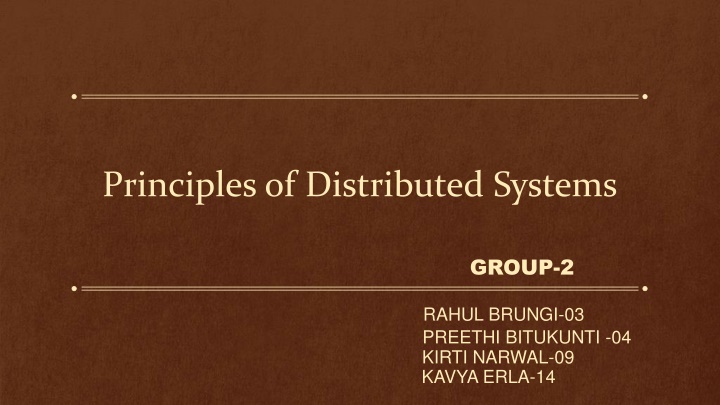
Optimization Statistics and Intermediate Relations in Distributed Systems
Explore the principles of distributed systems through topics like optimization statistics, intermediate relation sizes, histograms for selectivity estimation, and dynamic algorithms. Learn about cardinalities, selectivity factors, and join operations in distributed computing.
Download Presentation

Please find below an Image/Link to download the presentation.
The content on the website is provided AS IS for your information and personal use only. It may not be sold, licensed, or shared on other websites without obtaining consent from the author. If you encounter any issues during the download, it is possible that the publisher has removed the file from their server.
You are allowed to download the files provided on this website for personal or commercial use, subject to the condition that they are used lawfully. All files are the property of their respective owners.
The content on the website is provided AS IS for your information and personal use only. It may not be sold, licensed, or shared on other websites without obtaining consent from the author.
E N D
Presentation Transcript
Principles of Distributed Systems GROUP-2 RAHUL BRUNGI-03 PREETHI BITUKUNTI -04 KIRTI NARWAL-09 KAVYA ERLA-14
Outline Optimization Statistics Intermediate Relation Sizes Histograms for Selectivity Estimation Histogram Example Centralized Query Optimization Dynamic Algorithm Dynamic Algorithm- Decomposition Detachment
Optimization Statistics Primary cost factor: size of intermediate relations Need to estimate their sizes Make them precise more costly to maintain Simplifying assumption: uniform distribution of attribute values in a relation
Statistics For each relation R[A1, A2, , An] fragmented as R1, , Rr length of each attribute: length(Ai) the number of distinct values for each attribute in each fragment: card( AiRj) maximum and minimum values in the domain of each attribute: min(Ai), max(Ai) the cardinalities of each domain: card(dom[Ai]) The cardinalities of each fragment: card(Rj) Selectivity factor of each operation for relations For joins card(R S) SF (R,S) = card(R) card(S)
Intermediate Relation Sizes Selection size(R) = card(R) length(R) card( F(R)) = SF (F) card(R) whereS F (A = value) = 1 card( A(R)) 1 S F (A = value) = card( A(R)) value max(A) S F (A <value) = max(A) min(A)
Intermediate Relation Sizes Projection card( A(R))=card(R) Cartesian Product card(R S) = card(R)*card(S) Union upper bound: card(R S) = card(R) + card(S) lower bound: card(R S) = max{card(R), card(S)} Set Difference upper bound: card(R S) = card(R) lower bound: 0
Intermediate Relation Size Join Special case: A is a key of R and B is a foreign key of S card(R A=B S) = card(S) More general: card(R S) = SF *card(R) card(S) Semijoin card(R A S) = SF (S.A) *card(R) where SF (R A S)= SF (S.A) = card( A(S)) card(dom[A])
Histograms for Selectivity Estimation For skewed data, the uniform distribution assumption of attribute values yields inaccurate estimations Use an histogram for each skewed attribute A Histogram = set of buckets Each bucket describes a range of values of A, with its average frequency f (number of tuples with A in that range) and number of distinct values and Buckets can be adjusted to different ranges Examples Equality predicate : With (value in Rangei), we have: SF (A = value) = 1/di Range predicate : Requires identifying relevant buckets and summing up their frequencies
Histogram Example For ASG.DUR=18: we have SF=1/12 so the card of selection is 300/12 = 25 tuples For ASG.DUR 18: we have min(range3)=12 and max(range3)=24 so the card. of selection is 100+75+(((18 12)/(24 12))*50) = 200 tuples
Centralized Query Optimization Dynamic (Ingres project at UCB) Interpretive Static (System R project at IBM) Exhaustive search Hybrid (Volcano project at OGI) Choose node within plan
Dynamic Algorithm Dynamic (Ingres project at UCB) Interpretive Static (System R project at IBM) Exhaustive search Hybrid (Volcano project at OGI) Choose node within plan No statistical information is maintained
Dynamic Algorithm - Decomposition Replace an n variable query q by a series of queries q1 q2 qn where qi uses the result of qi-1. Detachment Query q decomposed into q' q" where q' and q" have a common variable which is the result of q' Tuple substitution Replace the value of each tuple with actual values and simplify the query q(V1, V2, ... Vn) (q' (t1, V2, V2, ... , Vn), t1 R)
Detachment SELECT V2.A2,V3.A3, ,Vn.An q: FROM R1 V1, ,Rn Vn P1(V1.A1 )AND P2(V1.A1,V2.A2, , Vn.An) WHERE SELECT V1.A1 INTO R1' q : FROM R1 V1 WHERE P1(V1.A1) SELECT V2.A2, ,Vn.An q": FROM R1' V1, R2 V2, ,Rn Vn WHERE P2(V1.A1, V2.A2, ,Vn.An)
Detachment Example Names of employees working on CAD/CAM project SELECT FROM WHERE AND AND SELECT FROM WHERE EMP.ENAME EMP, ASG, PROJ EMP.ENO=ASG.ENO ASG.PNO=PROJ.PNO PROJ.PNAME="CAD/CAM" PROJ.PNO INTO JVAR PROJ PROJ.PNAME="CAD/CAM" q1: q11: SELECT FROM WHERE AND EMP.ENAME EMP,ASG,JVAR EMP.ENO=ASG.ENO ASG.PNO=JVAR.PNO q':
